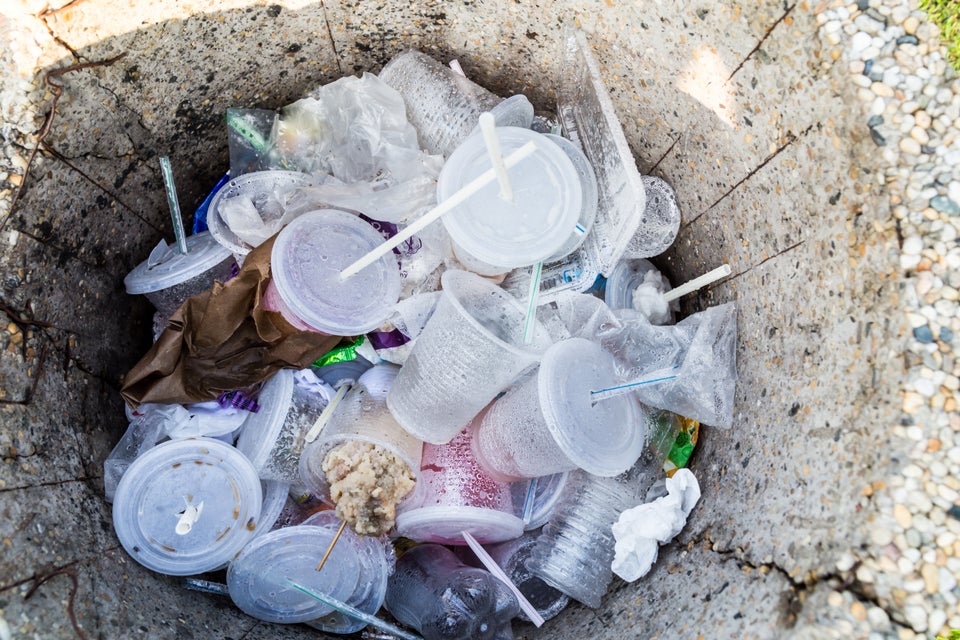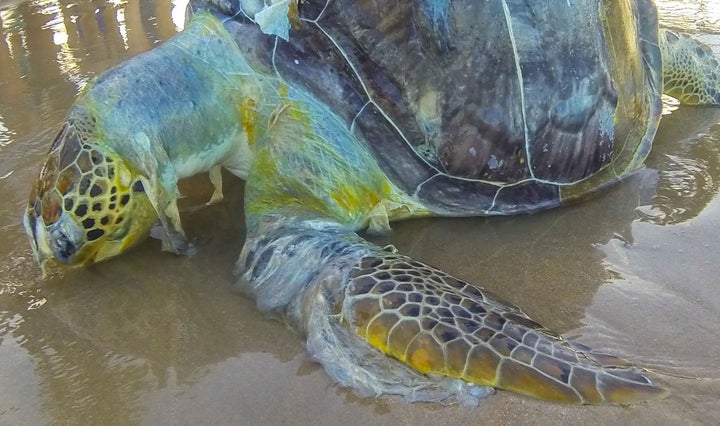
This story is part of a series on ocean plastics.
Every year, billions of pounds of plastic waste ― grocery bags, drinking straws, even cigarette butts ― pour into our oceans. Used by humanity for a few minutes at most, these single-use plastics likely will likely stick around for decades, or longer.
Trillions of pieces of refuse get trapped by natural ocean currents, or gyres, at five locations, causing a dance of debris for hundreds of thousands of square miles. While these gyres, geographically removed from civilization, hold much higher concentrations of trash than other regions of the ocean, they’re evidence of a growing problem humans have mostly ignored since we embraced widespread plastic use 50 years ago. But now, researchers are ringing a warning bell: Our reliance on cheap, disposable stuff is smothering the seas, and it’s bound to get worse.
Marcus Eriksen, a co-founder of the conservation group 5 Gyres, likens this growing horror to smog that covers cities like Los Angeles and Beijing.
It’s an apt description. Over time, a plastic item in the ocean breaks down into many tiny particles, known as microplastics ― so many, in fact, that if you were to stand on the bottom of the ocean in the middle of a gyre and look up, the water overhead wouldn’t look clear, Eriksen said.
“What you’d see are these massive clouds,” Eriksen said. “Clouds of micro- and nano-plastics stuck in the ocean’s gyres.”
Perhaps the smoggiest of these gyres is the Great Pacific Garbage Patch, hovering a few hundred miles north of Hawaii. Reports describe it as a floating island of trash twice the size of Texas, so dense you could walk across it, and so vast you can see it from space. But such descriptions are misleading, scientists say.
“The name ‘garbage patch’ is a misnomer,” wrote researchers at the National Oceanic and Atmospheric Administration’s Marine Debris Program in 2012. “There is no island of trash forming in the middle of the ocean, and it cannot be seen with satellite or aerial photographs.”
Rather, it’s more like a swarm of microplastic bits.
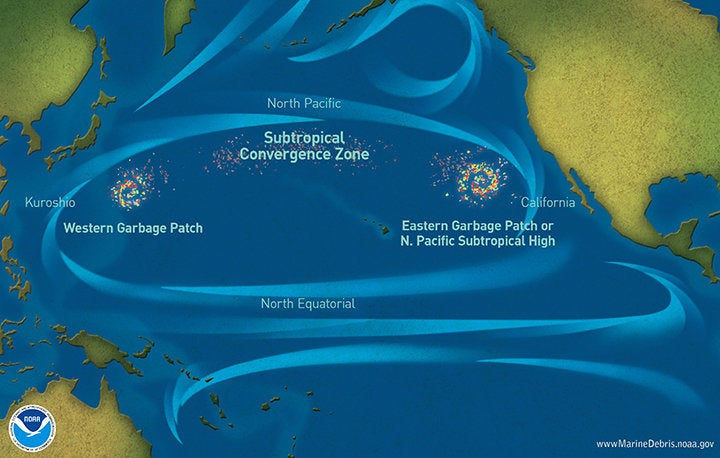
At last estimate, there were some 5.25 trillion pieces of plastic trash floating along the surface of the ocean. Waves, salt and UV radiation from the sun will eventually break down these items into microplastic particles, each less than 5 millimeters long. If you tried to account for not just the large pieces of plastic bobbing about, but also the particles, you’d be looking at a number close to 51 trillion, or “500 times more than the stars in our galaxy,” according to the United Nations Environment Program.
By now, plastic bits are so pervasive they’ve spread to some of the furthest reaches of the globe. Just last month, scientists said ocean plastic has started washing up in the Arctic for the first time.
“It’s on every beach, found in sediment worldwide, a small particulate that’s diffuse throughout the water column,” Eriksen said. “It’s a plastic smog throughout the world’s ocean.”
And, like its airborne namesake, this oceanic haze has not been harmless.
Plastic, It’s What’s For Dinner
Recent studies have linked the growing amount ocean plastic to a host of health impacts in marine creatures.
Dramatic photographs taken in 2011 were among the first to show such devastation: rotting albatross carcasses on Midway Atoll, a remote island in the North Pacific right in the middle of the region affected by the Great Pacific Garbage Patch. The images showed more than a dozen bird skeletons stuffed with colorful bits of plastic. Their stomachs were so full of the material that scientists said the animals died from malnutrition.
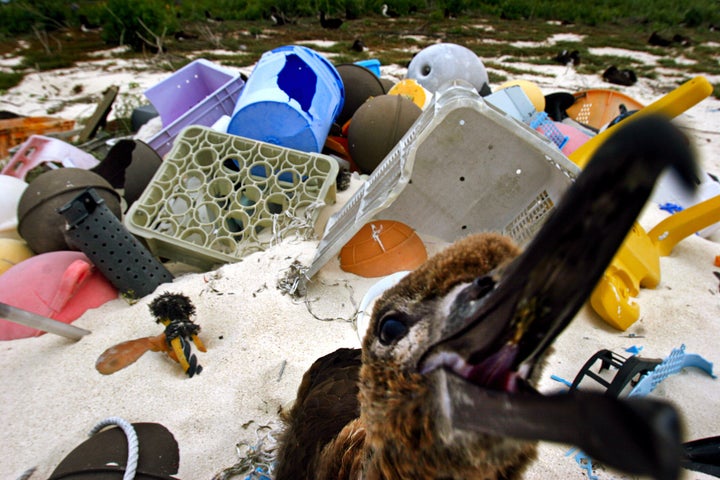
Researchers have since discovered that plastics bobbing in the ocean can pick up scents that marine birds have long associated with food sources. Albatrosses have a sharp sense of smell and will inadvertently gobble up a pen cap that smells like fish, for instance.
These impacts have spread as the trash multiplies. A paper published in 2015 found 186 species of seabirds are now at risk of plastic ingestion. It estimated that by 2050, 99 percent of all seabirds will have eaten plastic at some point in their lives.
Qamar Schuyler, a scientist with Australia’s Commonwealth Scientific and Industrial Research Organization, has documented a similar phenomenon in sea turtles. In a blog written for Greenpeace last year, Schuyler said that during her time as a biologist at The University of Queensland, about 30 percent of the turtles she performed necropsies on had plastic in their stomachs.
Schuyler speculated the turtles were confusing things like plastic grocery bags for jellyfish, a primary food source.
But people aren’t eating plastic particles, right?
Actually, science says yes, we are. A recent study found about one-fourth of seafood sampled from fish markets in California and Indonesia had plastic in their guts. While the link between fish entrails and our own stomachs isn’t fully understood (fish guts are usually removed before the fish reaches the dinner table), another study conducted among Europeans who ate large amounts of filter-feeding mussels and oysters found some humans consume up to 11,000 microplastic pieces per year.
It’s unclear what all of this ingested plastic can do to human health. “Our understanding of the fate and toxicity of microplastics in humans constitutes a major knowledge gap,” the U.N. Environment Program noted in a 2016 report.
The Great Ocean Cleanup Fallacy
The vastness of the marine debris problem has prompted dozens of grand repair efforts.
A project called The Ocean Cleanup, founded by an inventor named Boyan Slat when he was 18, aims to create a 62-mile, underwater, V-shaped barrier to trap plastic trash as it floats along ocean currents. Slat said the technology, which he hopes to deploy by 2020, could remove half of the trash from the Great Pacific Garbage Patch within a decade.
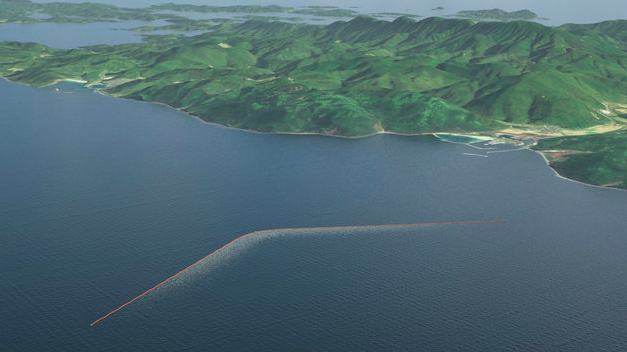
But scientists have cast doubt on such plans, saying efforts to clean up what’s already in the ocean are a distraction from the cause of the problem.
“Unfortunately, cleaning up the garbage patches is pretty complicated,” NOAA wrote in a January blog. “Since the debris making them up is not only constantly mixing and moving, but also extremely small in size, removing this debris is very difficult.
Eriksen calls such talk the “ocean cleanup fallacy,” and said efforts should actually focus on industries that create all the single-use plastic in the first place, and the consumers who use it.
Recycling rates in the U.S. have plateaued in recent years, and only about one-third of the country’s waste is recycled, according to the Environmental Protection Agency. Up to 75 percent of the waste stream could be reused if it were disposed of in the proper channels, the EPA said.
In the meantime, trash keeps accumulating in marine waters.
A recent report estimated that by 2050, there could be more plastic in the ocean, by weight, than fish. Eriksen noted that scientists now say the Anthropocene ― the next geological epoch that will be defined by humanity’s impact ― will almost certainly be linked to the prevalence of plastic around the planet.
“How do you define the Anthropocene? Some scientists say black carbon from fossil fuels, others radioactive isotopes,” Eriksen said. “Now people agree ― it’s plastic. It’s gone global.”

